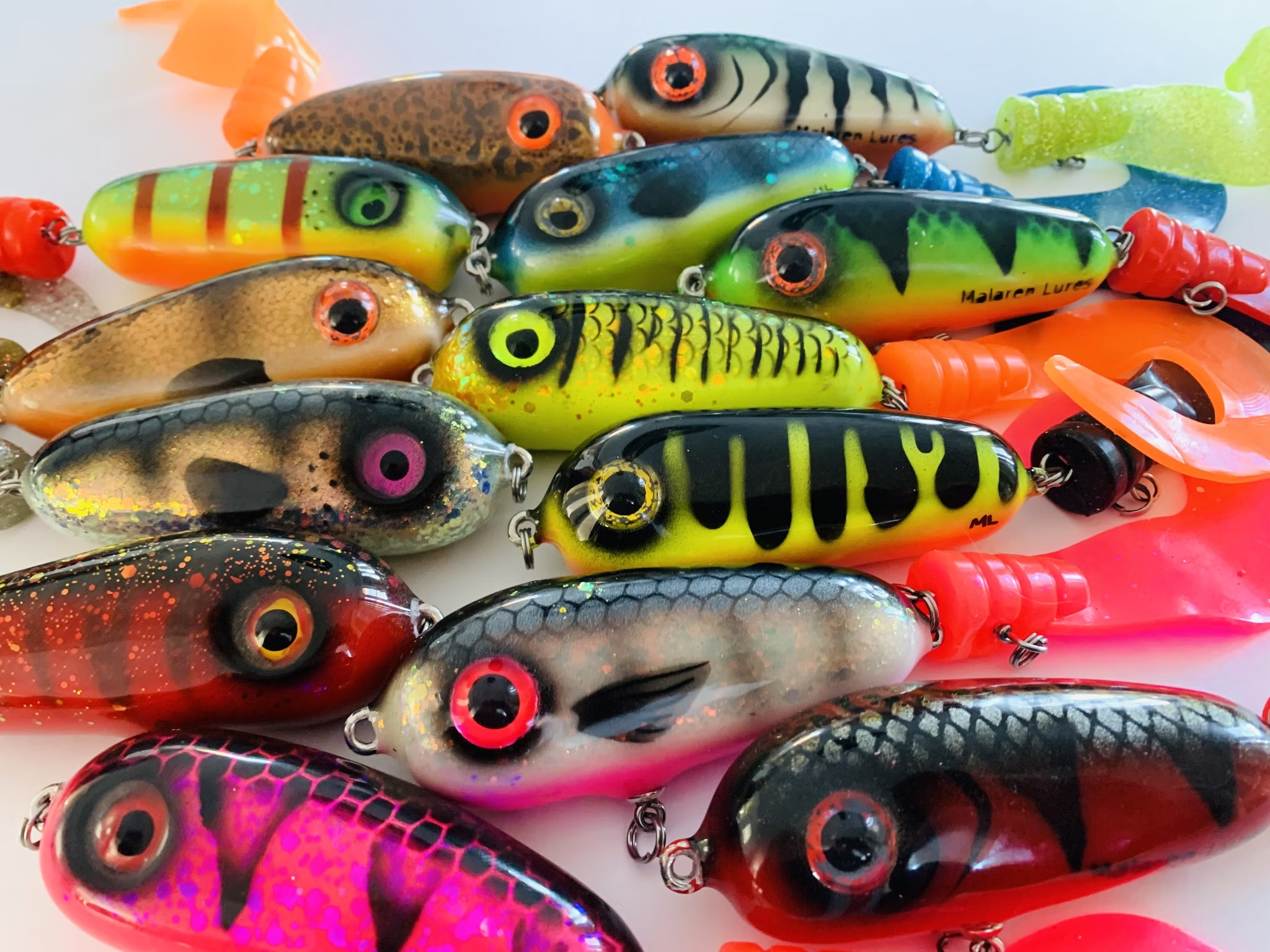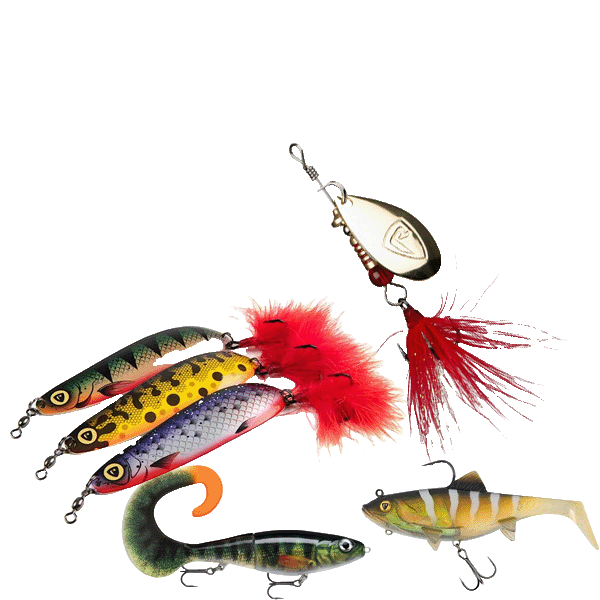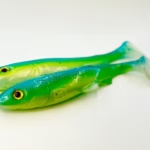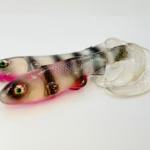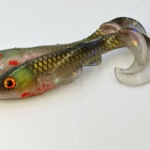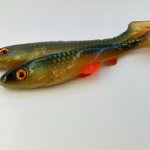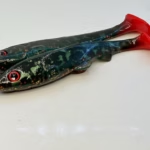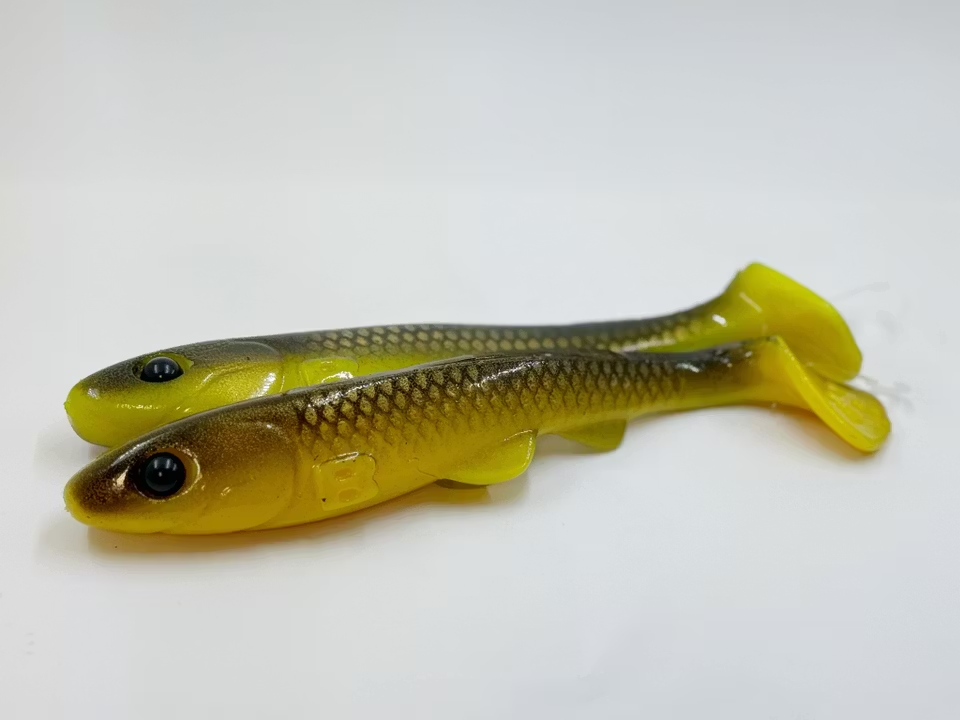
Fish Smarter With BONIbaits Happy Slim 27 cm
Can you have a big shad that you can crawl without wasted casts? Yes. The HappySlim 27 cm (195 g) gives you that slow, steady swim without feeling like a brick. Its slimmer belly and wide back throw a bold profile, so pike see “food”, not plastic. This guide links colour picks and retrieves to loughs, rivers, and canals you actually fish.
Meet the HappySlim 27: Shape, Profile, Specs
You want presence without drag. The HappySlim gives you that. A slimmer belly lets the body start easily at slow speeds. Meanwhile, the wide back throws a bold silhouette that pike pick up fast, even in stained water. That shape reads like a real baitfish from below, so follows turn into hits rather than lazy escorts.
This matters in Ireland’s rivers and lakes. Pike here feed hard on roach, perch, and other fodder fish, so a broad-backed shad makes sense to them on sight. On peat-tinged loughs, that bigger cross-section helps you stay visible without cranking the reel.
Size and weight are dialled for big pike work: Length: 27 cm. Weight: 195 g.
It’s a paddle-tailed shad built to swim slow yet still kick and glide. With the side-to-side swing and slow-friendly behaviour, you can crawl it across shallow reefs and cabbage beds without the lure dying on you.
Hooking is straight-forward. Run a two-treble stinger with 2/0 or 3/0 hooks to pin short takes.
Where it fits in your box
You reach for the HappySlim when you need a large silhouette without burning the bait. It shines over shallow ground, around reedbeds, and across wind-lanes where pike track slow movers. Crucially, it works with a shallow screw, so you keep the nose high and the swim level. That rig keeps you fishing in 1–2 m water where jigheads snag, and you can add a light chin-weight if the wind picks up.
So, in one lure, you get a bold profile, slow control, and simple rigging. Exactly what you need when Irish pike want an easy meal.
Who Should Fish with the BONIbaits Happy Slim 27 cm?
If you love slow water coverage
You like working methodically. You value control over speed. Then the HappySlim 27 cm (195 g) fits you. Its shape keeps a lively swim even when you crawl it, so you can comb shallow shelves, cabbage beds, and reed edges without racing the reel. It works slow and pairs neatly with a shallow screw for high-riding, snag-safe passes.
Cold snaps, bright sun, and weekend pressure all push pike off the chase. That’s when you’ll shine. Glide it, stall it, then give a short pull to re-engage the tail. The two-treble stinger in 2/0–3/0 helps pin tentative bites without over-bulking the body.
If you fish mixed Irish venues
You split time across loughs, rivers, and canals. You need one big shad that still behaves on slow retrieves. The HappySlim ticks those boxes. Lough drifts with wind lanes? Count it down, then sweep and pause. Canal margins with moored boats? Short pulls and hangs over 1–2 m are tidy on a shallow screw. River glides? Work the seam gently and let the bait track level.
Ireland offers broad pike access with year-round angling and a clear policy focus on sustainable fisheries—so you can plan varied sessions with confidence. If you fish different waters each week, this is a smart, steady choice.
Your Pike Struggles Solved One Cast at a Time
“Big shads need speed” — Not this one
It’s slow control without a dead lure. The HappySlim’s slimmer belly lets the tail start at low crank speeds, while the wider back keeps the body tracking straight. So you can crawl it over cabbage beds, then pause, and it still swings with intent. That matters on bright days and after weekend pressure when fish won’t chase.
“I can’t get a proper profile without heavy pull”
Big presence often means big effort. Not here. The HappySlim’s wide back throws a bold silhouette that reads like a roach or perch without you cranking hard. That profile is easy for pike to see in peat-stained Irish water, especially along wind lanes and reed edges. You get visibility without arm-ache, and you keep the lure in the strike zone longer.
“Slow fishing = poor hook-ups”
You worry that slow retrieves miss light takes. The fix is simple and tidy: a two-treble stinger in 2/0–3/0. It covers belly and tail bites without over-bulking the body. This keeps short strikers honest when you’re gliding and stalling the bait. If fish nip the tail during a pause, that rear treble does the work while the front treble tidies up side hits. Keep wire neat, split rings strong, and you’ll lift your land rate on lazy days.
“Shallow water eats my jig heads”
Weed, stones, and old cables love jig heads. So switch to a shallow screw. You twist the centre pin into the nose, clip your stinger to the belly anchor, and run the bait high over 1–2 m of water. It tracks level, clears salad, and still kicks at slow speed. Need a touch more depth in a crosswind? Add a small chin weight to the clip and carry on.
Side-to-Side Movement That Reads Like Dinner
The BONIbaits Happy Slim 27 cm (195 g) actually moves at a crawl. On a slow, even retrieve the tail kicks, the body tracks straight, and the head rocks just enough to push water. That side-to-side swing is what keeps pike following, then biting, even when they’re sulking. It matches what you see on the rod tip—steady thump without roll-over.
There’s more going on than looks. Predators key on hydrodynamic cues as well as sight. Fish detect tiny pressure changes through the lateral line, sometimes described as a “touch-at-a-distance” sense that picks up water movement around prey and lures (Review of lateral line function; Adaptive diversification review). That rhythmic push from the HappySlim’s tail gives pike something to home in on, even when they’re not chasing fast.
Why the baitfish imitation works
You often fish peat-stained loughs and slow rivers, where visibility drops. In such conditions, fish shift towards supplementary cues when vision becomes less reliable—hydrodynamics and vibration matter more, while flash matters less (Behaviour under degraded optical
conditions). The HappySlim’s wide back throws a bold silhouette that reads like roach or perch, while the controlled body roll adds just enough contrast without making the lure topple.
Now add local prey. Irish pike commonly target roach and other coarse fish. So when you present a broad-backed shad with a natural glide, you’re speaking their language.
Keep the retrieve slow and even. Feed in short pauses to let the body hang and sway. Then re-engage with a half-turn. You’ll maintain that lifelike side-to-side pulse, and you’ll trigger more confident takes—especially in stained water where that steady hydrodynamic “footprint” helps pike commit.
Rigging the BONIbaits Happy Slim 27 cm
The shallow-screw setup
Start simple. Take a medium or large shallow screw with a centre pin and twist it into the HappySlim’s nose until the coil sits flush. Clip your trace to the screw eye, then attach your stinger anchors. This setup keeps the lure level and running high in the water — perfect for 1–2 metre weedbeds. Use screws in the 5–7 mm range for a secure hold and keep a few spares in your tackle box. If wind picks up, clip a small chin weight or tungsten snap-on to add depth without rebuilding your rig. It keeps you fishing instead of wasting time re-rigging.
When should you add weight? If the nose rides too high in chop, add a light chin weight to settle the head and keep the tail thumping evenly. If you’re ticking weed, remove the weight and slow the retrieve. Quick adjustments like these are common advice in shallow-rig guides and shop primers.
Stinger (2/0 or 3/0)
Run a two-treble stinger: 2/0–3/0 trebles, one on the belly and one near the tail. Pin the belly treble just aft of the midpoint; place the tail treble at the beginning of the paddle root to catch nips on pauses. Keep your stinger wire tidy and just long enough to avoid fouling the tail—short, neat links hook better and cast cleaner.
Anti-foul tips? Pre-curve the wire slightly so it hugs the body, use quality split rings, and check the tail clearance with a slow pull by the rod tip before your first cast. If the rear treble brushes the paddle, shift it forward half a ring.
Leaders and clips
Pike have teeth like razors, so wire traces are standard. A trace over 30 lb (≈13.6 kg) and a main line of 30 lb braid or 15 lb mono are a sensible baseline. A short wire trace also protects fish by shortening fight time and preventing bite-offs. Heavy fluorocarbon (80–100 lb) may be an option in very clear water, but wire remains the safer choice for big pike. Use a strong cross-lock/fast-change clip that you can open cleanly with cold hands.
Common rig swaps
Weed lanes thickening up? Swap the rear treble for a single on a short assist to reduce fouling, or move to a weedless shallow-screw variant until you reach the edge of the bed. Shallow-rig articles show how to keep mounts compact, adjust the amount of lead, and simplify hook layouts so you still get positive sets without dragging salad every metre. If you want a deeper track for outer shelves, keep the shallow screw and add a small chin weight rather than jumping straight to a heavy jighead. This keeps the HappySlim’s steady, slow swim intact.
Finally, sanity-check your build. Hold the lure by the clip and shake it—nothing should rattle or swing loosely. Then make a short test cast. If it runs straight, pulses, and lands clean, you’re rigged right for a slow, controlled session with the BONIbaits Happy Slim 27 cm.
Retrieves For Irish Water Types
Loughs With Wind Lanes
Start by reading the wind. Across Ireland, the prevailing direction sits between south and west, with average annual speeds from 3 m/s in sheltered south Leinster to 8+ m/s in the far north. Wind lanes form slick “highways” where food gathers. So, set a quartering drift through a lane rather than running straight down it. Cast up-and-across the drift, let the BONIbaits Happy Slim 27 cm sink 3–6 seconds, then start a slow, even sweep.
Work a rhythm: five turns, one-second pause, two short pulls. Those pauses let the wide back hang and sway, which keeps the tail thumping without roll-over. If whitecaps push the nose high, clip on a light chin weight so the lure tracks level. Keep the rod low to the water to reduce bow in the braid. Then, as you cross the lane edge, add a half-turn pop to wake followers.
Target known big-fish venues with open water and baitfish. The Shannon system sprawls for 360 km, breaking into lough basins with wide drifts and clean wind fetch. On these broad reaches, long, patient pauses out-fish frantic retrieves. The steady side-to-side pulse sells “easy meal” far better than speed.
Rivers And Glide-Outs
Current changes the rules. Aim casts upstream at 45°, then slow-pump the rod tip as the lure swings across the seam. Count the lure down to just tick depth without snagging. Now keep a metronome pace: one half-turn, micro-pause, repeat. Use the pause to let the body pendulum towards slack water; that’s when pike dart out from cover.
On long glide-outs below weirs, hold the rod high and steer the HappySlim along the soft edge where bubbles thin. If the tail begins to “wash out,” angle the rod downstream to relieve pressure. When you reach a crease line, give two brisk handle turns to mimic a panicked roach. Then drop back to crawl speed so a tracking fish can commit.
The Shannon’s sheer length and basin flow create many such seams and glide-outs around islands and mouths of tributaries like the Inny and Suck. Focus on the first 30–50 metres below confluences; suspended fish often pin prey here.
Canals And Margins
Canals demand precision. You fish tight to boats, ladders, and reed clumps. So, go short pulls and stop-and-hang. Cast parallel to the bank, count two–three seconds, then work two short pulls followed by a one-second stop. The wide back holds the silhouette in place; the tail keeps signalling without forward travel. Pike sitting under hulls or along stonework need that static tease.
In very tight margins, switch to a shorter leader and keep the rod tip high to “lead” the lure past snags. If the rear treble kisses weed, slide it forward half a split ring to preserve the glide. The action remains convincing at low speed, so you still sell a roach profile without covering ground quickly.
After-Work Sessions
Time is tight. Bank angles rule. So, pre-plan three micro-sectors you can fish in an hour: a reed margin, a slipway, and a wind-pushed corner. Start at the upwind piece so you present with surface drift. Use a count-down to hit depth, then run slow sweep, half-turn, micro-pause.
Two passes per sector, then move—don’t loiter.
Check the evening breeze before heading out. Met Éireann’s wind pages show mean speeds and gust probabilities for your area, which helps pick safe, workable drifts and banks. Light crosswinds suit the shallow-screw build; steady onshore winds at 10–15 knots call for that small chin weight to keep the nose honest.
Finally, keep it tidy. Short leaders for canals. Chin weights for windy lough points. Quartering angles for lanes. With these small, consistent moves, the HappySlim’s slow, side-to-side swim stays intact, and your Irish sessions feel structured rather than rushed.
How Colours, Water Clarity, and Light Factor In
Peat-Stained Water Picks
Do you fish a lot of brown-tinged loughs? You need contrast. Go for dark backs with warm bellies and a bold tail tip. That combo cuts through stain and stays visible at slow speed. The BONIbaits Happy Slim 27 cm comes in patterns that do this well. Gold throws a deep back with a warm flash that reads in tea-coloured water. Perch adds vertical bars for extra outline when light is flat.
Work the colour with the sky. On overcast, favour stronger contrast—dark back, hot belly, bright tail. On bright spells, keep the contrast but dial back glitter to avoid spooking fish in the top metre. Because the HappySlim swims slow with a side-to-side pulse, you want colour that the pike can track during pauses too, not only during the pull.
Add a final tweak: a small chin weight in short, steep chop. It steadies the head so the colour blocks hold their line. Your silhouette stays readable instead of fluttering off course.
Clear Water Picks
As clarity rises, so should your naturalism. Pick baitfish tones with subtle flake and a moderate back-to-belly contrast. The ID style leans natural and clean, which suits clear margins, boat harbours, and sunny windows. Perch still plays on rocky points where perch shoals are common, but keep retrieves slower and pauses longer to sell the glide.
Think angles, not only colour. In clear water with sun on your side, present cross-light so the wide back throws a soft flash on each swing. That flash, paired with the steady baitfish
imitation, is what turns follows into bites at slow speeds.
Finally, carry two anchors in the box: one high-contrast (Gold/Perch) and one natural (ID). Swap based on sky, depth, and weed colour. With these options, you keep the HappySlim’s slow, believable swim while matching what pike can actually see on any Irish session.
Tackle Pairing: Rods, Reels, Line
Casting 195 g Without Pain
You’re throwing a 27 cm, 195 g shad, so pick a rod that’s happy in that range. A big-bait casting rod rated 120–260 g or 150–290 g gives you casting headroom and a safer load on the blank. That spread covers the HappySlim bait comfortably, so you cast smoothly instead of lobbing.
Now reels. For slow, steady retrieves, you need torque and a line pick-up that doesn’t rush. A round or large low-profile reel in the 300–400 size range is perfect. Many anglers go for a 5.8:1 gear ratio for winching heavy plastics—it gives roughly 30 inches per turn, making it easy to hold a slow crawl without unintentionally speeding up.
If you prefer a faster retrieve for better line control in crosswinds, a 7.6:1 ratio delivers around 40 inches per turn—just ease your handle speed to keep that lazy, natural swim. Look for models built for power, with strong gears and large handles that make every turn smooth and controlled.
Lines and Leaders
Go braid main line for casting distance and strike feel. You can find 40–60 lb braid for pike, scaling up with big soft plastics to resist shock on the cast and boatside lunges. With spools handle 50–80 lb braid you won’t be short of capacity even with thicker lines.
For pike, wire traces are non-negotiable. Inland Fisheries Ireland guidance calls for at least 20 cm of ~30 lb wire paired with strong main line. A 30–40 lb wire is a sensible everyday pick.
Match the terminal side to the lure. Use a strong cross-lock/fast-change clip that won’t spring under load. Keep trace length 18–30 cm to cover head turns. Then tie or crimp cleanly, and check everything after every fish. With this setup—rated rod, torque reel, braid + wire—you’ll cast the BONIbaits Happy Slim 27 cm all day, hold a slow cadence, and land fish without
bite-offs.
Troubleshooting: What To Do If It’s Not Swimming Right
Twisting: Your screw may be off-centre. Back it out, then re-seat the shallow screw so the eye sits dead straight with the spine. Even a few degrees can force a corkscrew path. If chop lifts the nose, add a light chin weight to settle the head and restore a clean thump.
Rolling: Check stinger tension. Over-tight wire can choke the tail, while a slack link can swing and tip the lure. Shorten or lengthen the rear stinger until the paddle clears freely on a slow pull. Re-position the rear treble slightly forward if it brushes the paddle root.
Tracking wide: The tow point often tells you. If the bait drifts left, re-seat the screw a touch to the right, and vice-versa. Also scan for a bent split ring or a kinked clip. Small hardware kinks create big steering errors.
No action at crawl: The BONIbaits Happy Slim 27 cm (195 g) is built to move slow, so re-check the basics: true screw, free tail, and a steady cadence. If it’s dead, the rig is the likely culprit
Care, Storage, and Longevity of the BONIbaits Happy Slim 27 cm
Store flat
That wide back stays true longest in a flat tray. Avoid cramming big shads upright; compression dents warp the profile over time. Keep each colour in its own sleeve to cut colour bleed during warm spells (manufacturer care notes on many soft plastics make the same point; heat accelerates dye transfer).
Heat straightening
Got a kinked tail after a hot car day? Dip the last third of the lure in hot (not boiling) water for 10–20 seconds, then straighten gently and lay flat to cool. This resets the paddle and removes slight bends without cooking the plastic (standard soft-plastic fix shown in many rigging guides).
Keep plastics separate
Different formulations can react. So, don’t mix brands in one pocket, and never store them pressed against hard baits. Use zip sleeves or original bags inside a shallow box.
Rinse and rotate
After a mucky session, rinse, dry, and re-bag. Swap any rusted split rings immediately; corrosion spreads fast in damp boxes. With a flat tray, mild heat resets, and tidy bags, your HappySlim 27 cm stays straight, swims slow, and keeps that bold profile day after day.
The Brand Behind BONIbaits Happy Slim 27 cm
You’re buying from a small Swedish maker that pours, trims, and paints by hand. No conveyor belt. The products are 100% handcrafted since 2015.” That’s a long runway of testing and tweaks before a bait ever reaches your box.
The range is tight, and that’s the point. You get a few shapes refined for pike rather than a hundred lookalikes. Quality cues are visible. Edges are clean. Paint lines are crisp. And colours aren’t random; the feed gets seasonal drops with natural baitfish tones and high-contrast options pushed live on socials when stock lands. That’s useful when Irish water swings from tea-stained to gin-clear in a week.
BONIbaits shares regular angler photos, reels, and catch claims across Facebook and Instagram, so you can see how the baits swim and where they’re being used. One post even shows a giant: close to 130 cm and 18+ kg on a HappySlim, caught in Germany.
So, you’re dealing with a hands-on maker that ships across the EU, keeps the catalogue focused, and talks directly with anglers. If you value craft over catalogue sprawl—and you want colours that actually suit Irish clarity swings—BONIbaits is a smart brand to keep on your shortlist.
Where HappySlim Sits In The Range
Happy vs HappySlim vs HappyHybrid
You’ve got three siblings to choose from, and each earns its spot.
HappySlim (27 cm, 195 g) — This is your slow-friendly, big-profile shad. It’s thinner than the
Happy, yet carries a wider back so it still shows strongly in the water. It has a convincing baitfish look, and a body that keeps moving at low cadence—ideal when you want presence without speed.
Happy (Classic) — A compact “do-everything” silhouette. It has a fuller body that suits standard shad tasks and moderate speeds across the same colour families. If you like a meatier feel and a familiar pull, the Classic covers it.
HappyHybrid (28–35 cm, ~88–250 g) — Now you’re adding paddle + curly tail on one frame. The Hybrid throws extra vibration and lift, so you can play higher in the column or push more thump when fish want a louder cue. There are 28 cm to 35 cm heavy builds, giving you options from surface-skimming shallow-screw work to deep, weighted runs.
How to choose:
Pick HappySlim when you want slow retrieve control with a large silhouette that still swims on the crawl.
Pick Happy (Classic) when you want a fuller shad feel and standard speeds.
Pick HappyHybrid when you need extra thump/lift or a shallower track without losing length.
This way, you cover three distinct jobs without buying near-duplicates.
Keep It Legal And Ethical
You fish a country blessed with water. Ireland holds ~144,000 hectares of lakes and ~70,000 km of rivers and canals, much of it prime pike habitat with shoals of coarse fish to match. Newer national accounting backs up the scale: the river and canal network exceeds 74,000 km, touching every county, with Cork, Donegal, and Mayo carrying about 31% of that length combined.
Where should you focus? Pike are most prevalent in the North, North-East, and Midlands, with strong stocks across Erne, Shannon-connected waters, and countless drumlin loughs; Cavan alone boasts 365 lakes linked to the Erne system. In short, access is generous, variety is huge, and you can plan sessions around wind lanes, shallow bays, and canal margins without driving half the day.
You may keep only one pike per day and must return any pike over 50 cm (fork length). There’s also a possession cap of no more than one whole pike under 50 cm or more than
0.75 kg of pike flesh. Finally, you cannot possess more than 12 coarse fish for use as bait, and live-baiting with fish is prohibited.
Good handling matters. Use a wire trace (pike teeth slice mono), keep unhooking tools ready, and minimise air time before release.
There’s no closed season for pike at national level (local exceptions can apply on some waters), so you can build a year-round routine and adjust tactics to temperature, clarity, and wind.
FAQs
Does the HappySlim 27 cm swim well at slow speeds?
Yes. The slimmer belly and wide back keep a steady side-to-side swim even on a crawl. It also works very good with shallow screw, so you can fish slow and high over weedbeds.
What hook setup should I use on this lure?
Run a two-treble stinger with 2/0–3/0 hooks: one on the belly, one near the tail. It pins short nips during pauses without over-bulking the body.
How do I rig it for shallow water, and how do I add depth?
Use a shallow screw for 1–2 m water. If wind lifts the nose, clip on a small chin weight to hold track and depth while keeping the glide.
What rod rating should I choose to cast 195 g safely?
Pick a big-bait casting rod rated above 195 g. Many pike sticks in the 120–260 g class load and cast this lure cleanly.
What quick checks should I do before the first cast?
Sight the tow point straight, keep stinger wires tidy, and test-swim by the bank or boat. Two minutes here prevents poor tracking later.



